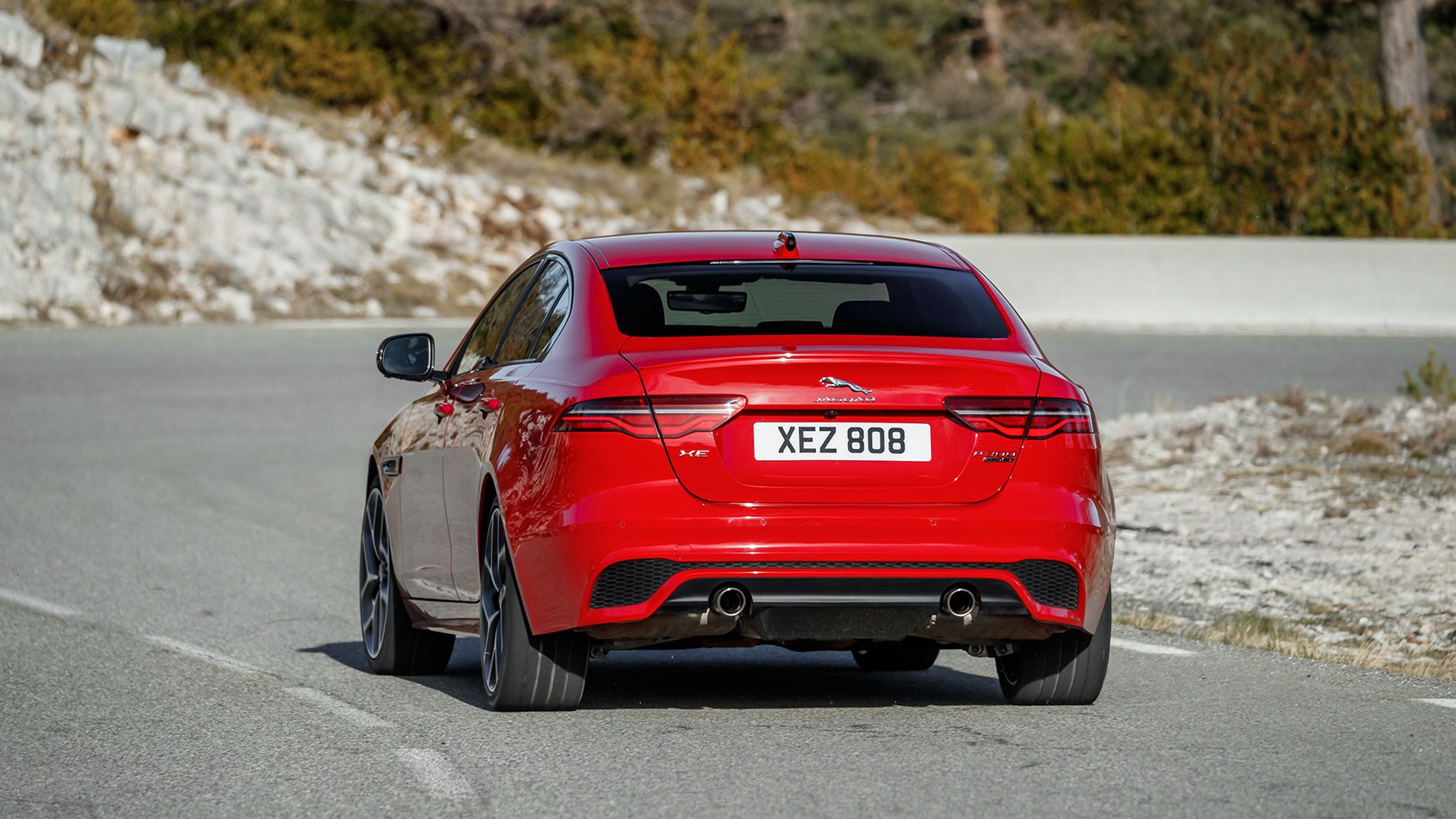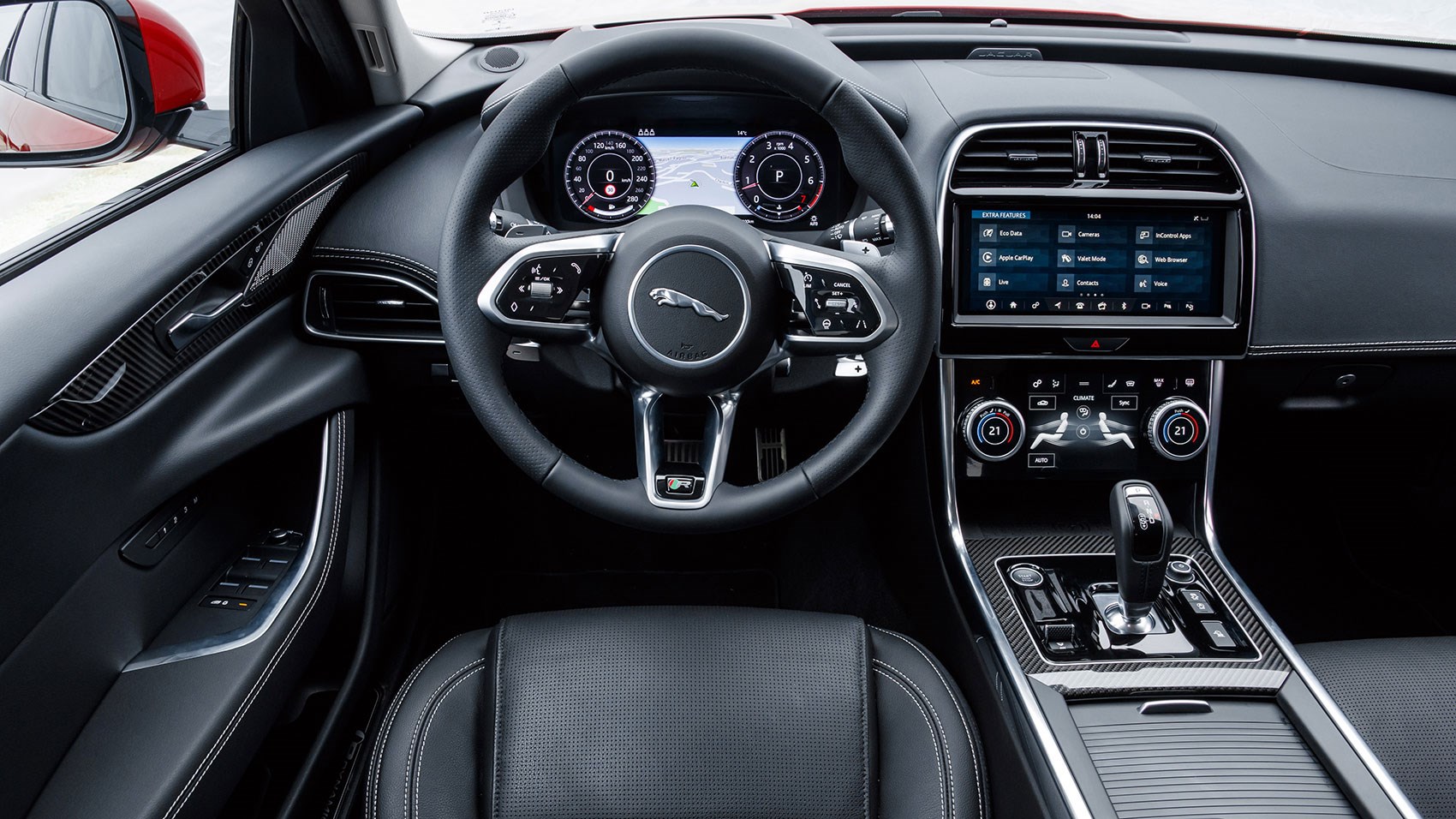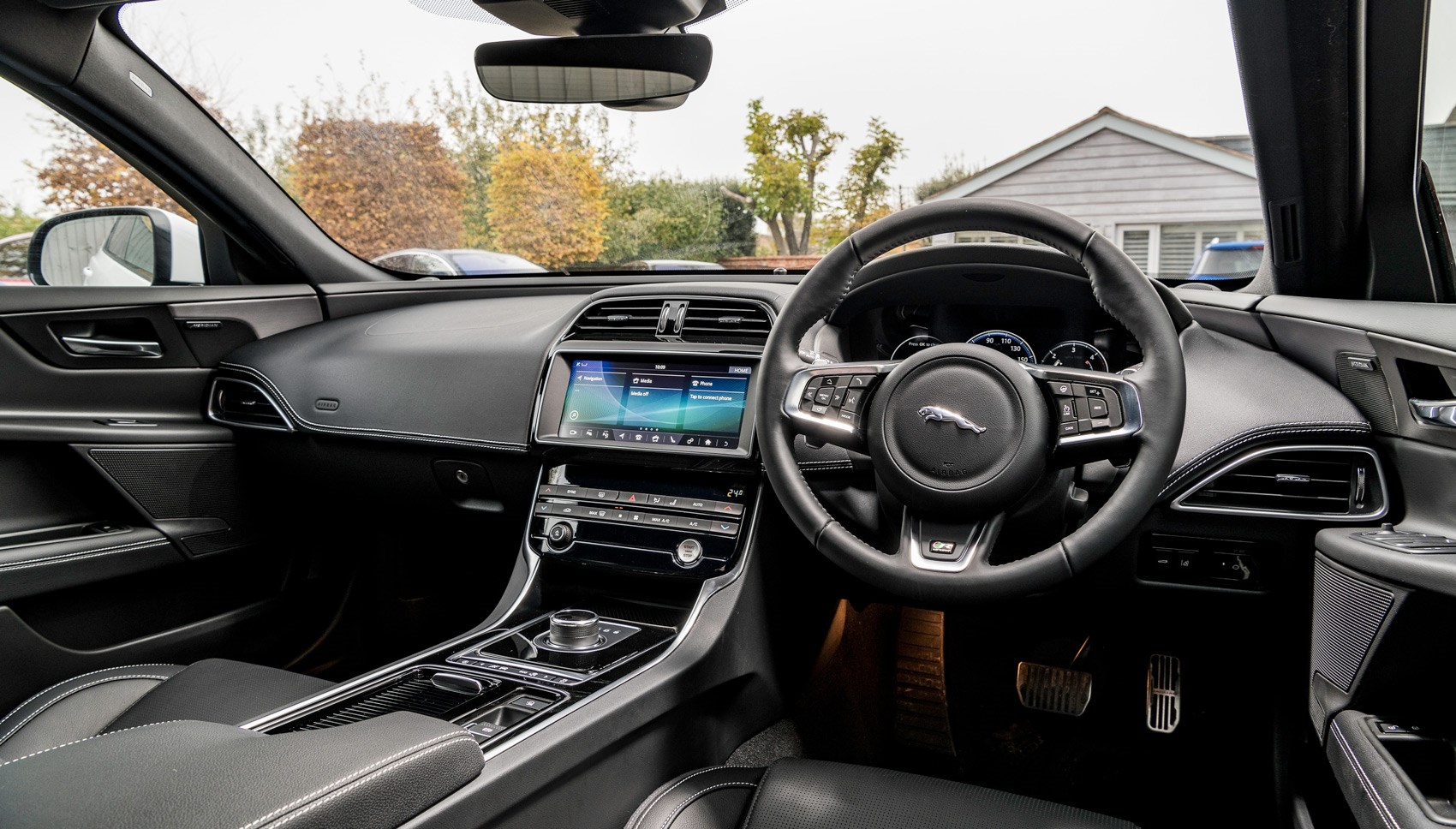► 2020 model-year Jaguar XE tested
► Our full compact exec saloon review
► Slimmed-down range, two models tested
The updated 2019 Jaguar XE has a tough and thankless task ahead of it. It goes up against the Mercedes-Benz C-Class, Audi A4, and new-for 2019 BMW 3-series – three of the most finely-honed cars known to man. But Jaguar hopes that an improved interior, sharpened styling, a simplified range and a more-focused P300 petrol range-topper will tear keen drivers away from the key premium class competition.
The key bullet points for the 2019 upgrades – dubbed 2020 model year – are that the range has been reduced to a single diesel, the 178bhp D180, available in rear- and four-wheel drive forms, and two petrols: the 247bhp P250 and 296bhp P300 – again both available in two- and all-wheel drive configurations.
Also, the interior – the XE’s biggest failing to date – has been given a brush-up, with updated infotainment and controls, and higher quality fit and finish. The range should be simpler to navigate, too, with two basic models – the standard and R-Dynamic versions, available in S, SE and HSE trims. Read on for our full 2020 model year Jaguar XE review.
What’s the range-topping P300 like to drive?
The numbers are competitive, if not earth-shattering. Packing 296bhp courtesy of a turbocharged 2.0-litre Ingenium petrol and assisted ably by four-wheel drive, the P300 R-Dynamic hits 62mph in 5.7 seconds. Fast enough, but that’s still slower than a 254bhp BMW 330d and practically the same as the 249bhp Audi A4 2.0 TFSI Quattro. Gone is the charismatic old supercharged 375bhp 3.0-litre V6 XE-S.

Other additions for the P300 R-Dynamic include elegant-looking 20-inch wheels, sports seats with colour-coded stitching across practically every surface inside, plus a fully specced-up chunky steering wheel lifted straight from the i-Pace electric SUV. Meanwhile, the entire model range now gets the upgraded 13.2-inch Touch Pro media system, with Range Rover Velar-style lower control screen in the upper models. That’s in addition to the fully digital instrumentation also available.
It’s worth noting early on that although the interior doesn’t look that different before, as the overall architecture is unchanged, the use of higher-quality materials and chunkier-feeling touch points have made a difference to the overall impression given by the XE. It’s still not up there with the Audi A4 or new BMW 3-series for interior creds, but it’s not far off the Mercedes-Benz C-Class (if not in terms of tech) and ahead of the Alfa Romeo Giulia for cabin ambience.
Jag XE P300 Sport: fast, comfy and sharp enough for most drivers
Though it’s not the most exciting or interesting-sounding engine in Normal mode, switch to Dynamic and the engine sounds surprisingly sharp for a four-pot. Meanwhile, the steering is satisfyingly weighty and fluid in its response, but nicely precise, with a small, chunky wheel. Providing a good sense of control around bends without being too sharp, it’s the perfect set-up for a small Jaguar.
Handling poise has always been the XE’s strong suit and the 2020 model year does nothing to dilute that keen athleticism.
This XE may be outgunned by less powerful rivals, but the 2.0-litre motor is still pretty capable. It feels strong, offers a broad spread of power and proves refined when cruising while producing a satisfying snarl when worked harder in Dynamic mode. Jaguar is clearly working hard to improve the Ingenium engine along the way, as it certainly wasn’t always the case.

The suspension mimics this with firm and well-controlled damping, but a very smooth ride, feeling well judged for UK roads: planted around corners, but soaking up bumps surprisingly well. The supportive sports seats add to this impression, offering good back support, while clamping you in place much better than in less powerful XEs. Bigger drivers will want to try before they buy to ensure they fit comfortably, though, as headroom can be limited.
The gearbox, meanwhile, is less-than-perfect. It’s mostly smooth and responsive enough to feel sporty in normal driving, but when the going gets tighter, it becomes more frustrating than helpful, either proving slow to respond to throttle inputs or hanging on to low gears for too long when it doesn’t need to. In short, you’ll give up bothering leaving it to its own thing on B-roads, choosing instead to row it along with its paddle-shifters.
Jaguar XE D180 SE: surprisingly agile and satisfying
Previous experience of the 178bhp diesel had us going into this drive with low expectations, following on from the more glamorous P300 – but it actually proved to be the star of the range. Diesel still makes plenty of sense for many drivers – not everyone lives in London – and the XE is a good example of how there’s plenty of life left in the old dog yet. The 178bhp motor has been continuously improved, and here it’s reasonably refined throughout the rev range, is punchy from low revs, and matches up nicely with its eight-speed transmission.
Should you still consider a diesel engine: we look at the petrol vs diesel debate

It offers strong enough performance – even with power-sapping all-wheel drive – and allies nicely with its pliant ride (on standard 18s, it’s more forgiving than on the 20s you get on the R-Dynamic models), excellent damping and fluid, well-weighted steering.
If anything, the steering is better weighted and provides more confidence here than it does in the P300. The ride is also smoother and the handling more precise than the more overtly sporting drive petrol. As with the petrol, we didn’t find the relatively wide front seats very comfortable, offering little side support and an oddly shaped backrest.
Verdict
The 296hp turbocharged 2.0-litre in the 300 Sport suits the XE well, offering plenty of power, driveability and impressive comfort and roadholding. It’s an engaging driver’s car that makes a lot of sense, if you’re not too hung up on it being a four-cylinder player against some very talented six-cylinder rivals from Germany.
The diesel, however, is probably still the best all-rounder for most drivers in the UK and Europe, as long as the legislators allow it to remain that way. It uses way less fuel, steers nicely and looks good. It’s just a shame that we’re currently limited to the 178bhp model, as it’s outpaced by the new BMW 320d.
Has Jaguar succeeded in improving the appeal of the XE? Yes, it’s sharper-looking and offers better interior quality than before. Dynamically it’s up there with the best, and it’s no longer the rolling disappointment it used to be inside. On purely rational grounds, it’s outgunned by the BMW 3-series and Audi A4, but emotionally, it’s now up there with the Alfa Romeo Giulia – and therefore still in the game.
Specifications quoted are for P300 R-Dynamic
Our earlier 2019 model year Jaguar XE reviews

The Jaguar XE may be a rare sight compared with equivalent C-Class, 3 Series and A4 models, but Jaguar hopes the new range-topping 300 Sport will tear keen drivers away from the outgoing 3 Series – which dies any day now – and the comfort-biased C-Class, the key rear-wheel drive competition.
Packing 296bhp courtesy of a turbocharged 2.0-litre and all-wheel drive, the 300 Sport hits 62mph in 5.7 seconds. Fast enough, but that’s still slower than a 254bhp BMW 330d and practically the same as the 249bhp Audi A4 2.0 TFSI Quattro. Gone is the supercharged 375bhp 3.0-litre V6 ‘S’.
Other additions for the 300 Sport include unique badging and trim, violent yellow stitching across practically every surface inside, plus more sober grey wheels. Meanwhile, the entire model range now gets the 10-inch Touch Pro media system, along with a higher-quality feel courtesy of new trim and – mmm – ‘premium’ carpet mats.
XE 300 Sport: fast, comfy and sharp enough for most drivers
This XE may be outgunned by less powerful rivals, but the 2.0-litre motor is still pretty impressive. It feels strong, offers a broad spread of power and proves particularly refined when cruising while producing a satisfying snarl when worked harder in Dynamic mode.
Though it’s not the most exciting engine in Normal mode, switch to Dynamic and the engine sounds surprisingly sharp for a four-pot. Meanwhile, the steering is satisfyingly weighty, but nicely precise, with a small, chunky wheel. Providing a good sense of control around bends without being too sharp, it’s the perfect setup for a small Jaguar.

The suspension mimics this with firm damping, but a very smooth ride, feeling very well judged for UK roads; planted around corners, but soaking up bumps surprisingly well. It feels like Jaguar has spent much more on the suspension here than in the 197bhp petrol model.
The body-grasping sports seats add to this impression, offering good back support, while clamping you in place much better than less powerful XEs. Bigger drivers will want to try before they buy to ensure they fit comfortably, though.
The gearbox, meanwhile, is not so polished. It’s mostly pretty smooth and responsive enough to feel sporty. However, the eight-speed unit in equivalent BMWs is much quicker to respond and smoother to boot.

Expect to pay just under £500 per month on a four-year, 10,000-mile-per-year PCP contract with a £5,000 deposit. In comparison, R-Sport trim with the same engine is just over £400 per month. That’s where our money would go.
XE 20t 200 R-Sport: less comfy and less sharp than 300 Sport
If you’re hoping to get much of the 300 Sport’s feel in a cheaper package with the 197bhp 2.0-litre rear-wheel drive model, prepare to be disappointed. Even in R-Sport form, the suspension is much busier and less composed than that in the 300 Sport and the steering lighter and less precise.

The engine is reasonably smooth and surprisingly muscular in gentle driving. Push harder, though and there’s less punch than you initially think. It’s still more than enough for most drivers and pretty refined, though not the most cultured unit. The gearbox is a little underwhelming, too. Quick enough, but not always finding the gear you want.
XE 20d 180 R-Sport AWD: too expensive, too dieselly
Diesel still makes plenty of sense in some cars. But not this one. The 178bhp motor is loud and rougher than you’d expect in a Jaguar. It offers strong enough performance – even with power-sapping all-wheel drive – but it feels heavy and the engine somewhat resistant. A diesel Mazda 6 is far smoother and has a wider spread of power.

Worse still, the auto gearbox typically holds the engine at low enough revs to throw up a lot of vibrations. Switch to Sport mode, however, and it chooses lower gears and kicks out lots of engine noise. While smooth enough normally, the gearbox is a little abrupt when changing down and under faster driving, too.
Surprisingly, the steering is better weighted and provides more confidence than the 200 petrol’s. The ride is also smoother and the handling more precise than the two-wheel drive petrol. As with the petrol, we didn’t find the relatively wide front seats very comfortable, offering little side support and an oddly shaped backrest.
Verdict
The V6 may be gone, but the 296hp turbocharged 2.0-litre in the 300 Sport suits the XE well, offering plenty of power, driveability and impressive comfort and roadholding. Get this engine with R-Sport spec and it makes a lot of sense, adding good value to the equation if a busier ride.
The diesel, however, is hard to justify on Jaguar’s PCP finance (at £373 per month in all-wheel drive form, £343 with two-wheel drive) compared with £287 for the more powerful 197bhp petrol. Yes, the diesel uses less fuel, but since it’s not the nicest engine, we’d steer clear. The petrol, meanwhile, has a more pleasant engine but doesn’t drive as well.
So, if you want a Jaguar for looks and feel, go for the 197hp petrol and it’s top value. If Jaguar means a fine balance between comfort and handling to you, however, stretching for the 296hp petrol R-Sport will be worth every penny.
By Chris Lloyd
Check out more Jaguar reviews here